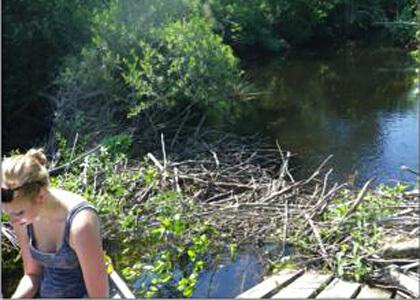Despite the recent focus on direct sources of greenhouse gas (GHG) generation such as fossil fuel burning and deforestation, the scientific understanding of indirect sources of greenhouse gas generation still remains elusive. Whether or not indirect sources are major contributors to climate change, it is imperative to fully comprehend every source in order to create an accurate budget of GHG emissions. Due to rising beaver populations in North America, beaver ponds have grown to be of particular interest as indirect sources of GHGs. From their ability to extend water retention times and accumulate organic matter, these ponds provide anaerobic conditions perfect for methanogenesis and denitrification, processes that produce carbon dioxide (CO2), methane (CH4) and nitrous oxide (N2O) – all GHGs of great concern. Over the past summer I spend my time investigating these emissions while working at the University of Rhode Island’s Watershed Hydrology Lab under the mentorship of Dr. Arthur Gold. Dr. Gold focuses specifically on understanding the role of nitrogen sinks, including riparian areas, streams and reservoirs, on total nitrogen output from land use and on the role of watershed features and human activities on stream flow regimes. In addition to his own research, he also works to support the research of his graduate and undergraduate students in areas related to nitrogen cycling and stream flow.
My separate research project specifically followed the research of one of Dr. Gold’s Ph.D. students, Julia Hyman. Julia’s research focused on the effects of beaver ponds on aquatic ecosystem functioning with a concentration in microbial biomass, organic matter accumulation and nutrient cycling. After a few weeks of working in the lab and out in the field my observations of Julia’s research led me to investigate biogeochemical cycling within aquatic anaerobic sediments of beaver ponds and the possible emissions of CO2, CH4, and N2O from these processes. The potential formation of these potent GHGs led us to hypothesize that beaver ponds represent a hotspot for emissions that could change the net assessment of GHG flux within forested landscapes. Our focus was to understand i) the range of greenhouse gases in beaver ponds, ii) which greenhouse gas dominated emissions, and, finally, iii) the characteristics that controlled the rate and type of greenhouse gas flux. In order to observe the nutrient processing and the resulting gas formation within sediments, Julia and I collected sediment cores from three different beaver ponds in Rhode Island and used mesocosm studies to assess the greenhouse gas flux. Experiments were run at pond temperature in a climate-controlled chamber located at the University of Rhode Island’s Bay Campus. In order to analyze sediment and pond characteristics, percent organic matter was found using the loss on ignition method and water temperature, dissolved oxygen, and flow regime was recorded on site.
After running gas samples on a gas chromatograph and completing a statistical analysis of each ponds difference, greenhouse gas emissions between sites showed variable results. For comparison, gas concentrations from each site were converted to a rate in CO2 equivalents in mg m-2 day-1 and then converted to the total percentage of the gas sampled. From these values, it could be seen clearly that Site 3 exhibited the highest amount of GHG emissions per day, while Site 1 and 2 had similar emission concentrations per day that were substantially lower (Tables 1, 2, & 3). High emission rates from Site 3 suggest that beaver ponds do in fact have the potential to alter GHG flux within forested landscapes. This conclusion causes us to wonder how increasing beaver populations will affect the total GHG budget in comparison to other indirect sources. Site 3’s high level of GHG may be related to its sapric (very mucky) organic matter, stagnant water and warm temperature, which provide ideal conditions for denitrification, methanogenesis, and decomposition. The role of the quality of organic matter, flow regimes, and seasonal patterns should be explored further. Although overall sites did differ, throughout all sites, methane emissions were the largest, dominating Site 1 by 45.3%, Site 2 by 74%, and Site 3 by 99.2% of each sites total gas emissions. Such high emission rates indicate the importance of methanogenesis and the need to study this process further, particularly in beaver ponds. It is especially important that rising beaver populations are taken into consideration and these ponds are included in net assessments of GHG flux.
Although this study may seem to emphasize the negative aspects of rising beaver populations it is important to remember that beaver dams actually exert many positive impacts on stream channel morphology and water quality. Their dams provide natural gradients and result in formation of large pools which trap and filter sediment from the stream flow. These pools generate higher water tables, which promote willow colonization and thus promote bank stability. While presenting my final conclusions at the Rhode Island Poster Conference I received many questions about what my research suggests. Many made the conclusion that rising beaver populations should be managed closely and perhaps stabilized. While this is understandable considering CO2, N2O, and CH4 can significantly affect climate change, it is important to realize that this study was not about the importance of managing populations, but rather about the importance of the understanding the different sources of greenhouse gases throughout the world. Without this knowledge our decisions regarding climate change management could possibly fall short. It is important that we fully understand all sources in order for our net assessment of GHGs to be exact.

July 18, 2013